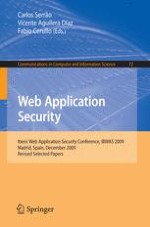IBWAS 2009, the Iberic Conference on Web Applications Security, was the first international conference organized by both the OWASP Portuguese and Spanish ch- ters in order to join the international Web application security academic and industry communities to present and discuss the major aspects of Web applications security. There is currently a change in the information systems development paradigm. The emergence of Web 2. 0 technologies led to the extensive deployment and use of W- based applications and Web services as a way to develop new and flexible information systems. Such systems are easy to develop, deploy and maintain and they demonstrate impressive features for users, resulting in their current wide use. The “social” features of these technologies create the necessary “massification” effects that make millions of users share their own personal information and content over large web-based int- active platforms. Corporations, businesses and governments all over the world are also developing and deploying more and more applications to interact with their bu- nesses, customers, suppliers and citizens to enable stronger and tighter relations with all of them. Moreover, legacy non-Web systems are being ported to this new intrin- cally connected environment. IBWAS 2009 brought together application security experts, researchers, educators and practitioners from industry, academia and international communities such as OWASP, in order to discuss open problems and new solutions in application security. In the context of this track, academic researchers were able to combine interesting results with the experience of practitioners and software engineers.
